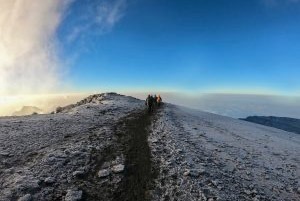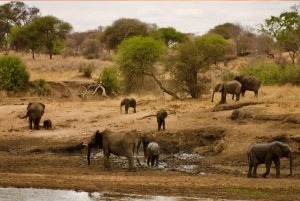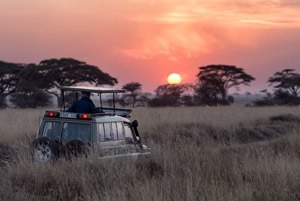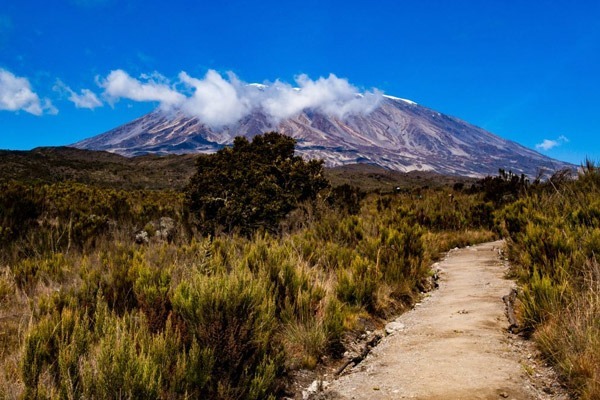 Day 1 – Arrive Moshi
Day 1 – Arrive Moshi
Jambo! Welcome to Tanzania. Your adventure begins with a welcome reception at the airport. Transfer to your hotel and enjoy sometime by the pool. If we’re lucky and the weather allows, you may catch a glimpse of Mount Kilimanjaro during sunset. This evening there will be a full briefing with questions and kit inspection by an experienced Kilimanjaro climber guide. Afterwards enjoy a group dinner and prepare for your trek the following day.
Day 2 – Hike to Mandara Hut
Breakfast at the hotel. Meet your guides and porters. Each person has a personal porter and there are extra porters for camping equipment and food. Before our trek we will proceed to visit the Kilimanjaro Porters Assistance Project. Learn how various projects support the people who are part of the crew accompanying you to Mount Kilimanjaro.
Head to Marangu Gate, the entrance to Mount Kilimanjaro National Park(6100ft). With introductions and assignment of porter loads taken care of, it’s time to embark on the trek of a lifetime.
Day 3 – Horombo Hut – Acclimatization Day
After breakfast, head out to Horombo Hut – another long hike over a slightly steeper stretch about 7.5 miles (approximately 5–7 hours).
You have a chance to see the rainforest give way to open and rolling alpine meadows dotted with giant heather trees. Once out of the forest canopy, the twin snow-tipped peaks of Kibo and Mawenzi lie directly ahead. These are two of the three great cones of Kilimanjaro (the other being Shira). During the day’s walk we will traverse several ravines before reaching the hut, which is set in a rocky valley. There is time to enjoy a wide variety of vegetation and changing landscapes on the way to Horombo Hut (12,400 ft). We will spend the next 2 nights here.
After breakfast, walk towards Mawenzi Hut, passing the unusual Zebra Rocks on the way. It’s a steep climb up a grassy slope, but well worth it: the views over the area towards Kibo are second-to-none. Afterwards, return to Horombo for lunch. Spend the afternoon relaxing and acclimatizing to the altitude or ask your guides about short walks in the area. Take advantage of the rest day here and drink plenty of water, the next couple of days will be challenging.
 Day 4 – Hike to Kibo Hut
Day 4 – Hike to Kibo Hut
After breakfast, you’ll walk 6 miles or so from Horombo to Kibo Hut (approximately 5–7 hours). As the journey progresses you will notice the landscape gradually becoming more rugged and rocky, and the air noticeably thinner.
We will have to soften our pace a little to accommodate these environmental changes. Marvel at giant groundsels and lobelias while you travel across the sparse moorland.
We will reach Kibo Hut in afternoon (15,550 ft), take the opportunity to have an early night in preparation for a very early wake-up call.
Day 5 – Summit Day
Your guides will wake you up at 11 pm (technically still day 5) and hot tea will be served. This will be for the final stretch to the summit. The distance from Kibo Hut to Uhuru Peak is 3.7 miles (approximately 6–8 hours), and then the descent to Horombo will be approximately the same amount of time. The trek begins beneath the stars as you maneuver your way up the slope, guided only by torch light, to reach Gilman’s Point (18,650 ft).
Arrive in time for breathtaking views of the sun rising behind Mawenzi Peak. You need to keep very warm as the morning is very chilly and cold. The breathtaking spectacle of the sun rising over the ice fields of the crater will make the early wakeup a memory and worthwhile experience. For those who still have the energy, it’s a further walk (approximately 2 hours) along the rim of the crater to Uhuru Peak (19,341 ft), the highest point in Africa. From here there are amazing views of the crater, ice fields, and plains below. After photos and time to catch your breath, descend back to Horombo Hut for a well-earned rest.
 Day 6 – Horombo Hut back to Mosh
Day 6 – Horombo Hut back to Mosh
After breakfast, continue your descent through alpine meadows and rainforests to the park gate. The distance from Horombo to Marangu Gate is 12 miles (approximately 5–6 hours). There will be vehicles waiting at the gate to take you and the crew back to the hotel. Enjoy an invigorating relaxing hot shower – a real treat after the intense physical effort of the last few days. Over a celebratory barbecue, relive and share your experiences of the past five days on the mountain. Overnight at the hotel.
Day 7 – Transfer to Tarangire National Park
If you are only trekking, you are free to depart anytime. For those staying on for a Safari extension, we make our way to Tarangire National Park to arrive for check-in and lunch. In the afternoon proceed for game viewing
Tarangire Park is often referred to as the “home of elephants” and is one of East Africa’s best places to see them up close, hosting approximately 4000 elephants. After game viewing head back to the camp to enjoy dinner and an overnight stay at the private camp under African skies. The national park is home to the second highest concentration of wildlife in Tanzania, after the Serengeti Ecosystem.
Day 8 – Tarangire National Park
Today you will start around sunrise for a morning game drive and follow that up later with an afternoon game drive. The animals tend to be more active in the cooler hours of the day. Typically we will return to the lodge during the hotter hours in the middle of the day, relax and maybe take a siesta. As always – this depends on wildlife movements and opportunities for sightings, the drive may continue through lunch and last all day. In this case, you will return to the lodge in the late afternoon. This is Africa, be prepared for anything.
Day 9 – Ngorongoro Conservation Area / Karatu
Breakfast at the lodge. Afterwards, check out and drive to Karatu. We will participate in a local community village program. A small village community, Mto Wa Mbu offers an excellent way to get a close-up look at life in an African town away from the main tourist trail. There’s an option to join a local community and visit the Meserani snake park where you will have an information session centered on the Maasai people and their culture.
 Day 10 – Serengeti National Park
Day 10 – Serengeti National Park
Travel to the Serengeti National Park (approx. 4 hours by road). To reach the Serengeti you must travel through the Ngorongoro Conservation Area – the outskirts of the famous crater.. Along the way, you have the option of visiting Olduvai Gorge, a site famous for the discovery of human ancestor remains that provide the most continuous known record of human evolution during the past 2 million years. Proceed to the camp for check in followed by lunch. Relax in the early afternoon before departing for a game drive. The wide, open plains of the Serengeti – are perhaps the quintessential image of Africa.
Day 11 – Serengeti National park
Start around sunrise for a morning game drive and follow that up later with an afternoon game drive, as the animals tend to be more active in the cooler hours of the day. The seemingly endless Serengeti Plains capture the essence of Africa. They are home to massive numbers of grazing animals and various predators, and the interaction between the many species often provides some of the best wildlife viewing opportunities in the world.
 Day 12 – Serengeti and Ngorongoro Crater
Day 12 – Serengeti and Ngorongoro Crater
Today you will explore the world-renowned Ngorongoro Crater, widely regarded as a microcosm of natural habitats in Africa and often touted as a veritable Garden of Eden. Within this crater lies every type of ecosystem, including riverine forests, open plains, freshwater, and alkaline lakes. Ngorongoro Crater is the remnants of an ancient volcano caldera, and within its 300 square kilometers is a remarkable concentration of wildlife. The scenery is spectacular as you descend almost 600 meters down to the crater floor. There is every chance that you will see a considerable variety of wildlife in this compact area, including the highly endangered black rhinoceros.
In the afternoon, you will leave the crater and then drive for 1.5hrs to reach Karatu. Check-in, have lunch with rest of the afternoon at leisure.
Day 13 – Depart
After breakfast, check out and proceed on to the airport. Hopefully there will be clear skies and fantastic views of the mountain from the road.

 Day 1 – Arrive Moshi
Day 1 – Arrive Moshi Day 4 – Hike to Kibo Hut
Day 4 – Hike to Kibo Hut Day 6 – Horombo Hut back to Mosh
Day 6 – Horombo Hut back to Mosh Day 10 – Serengeti National Park
Day 10 – Serengeti National Park Day 12 – Serengeti and Ngorongoro Crater
Day 12 – Serengeti and Ngorongoro Crater